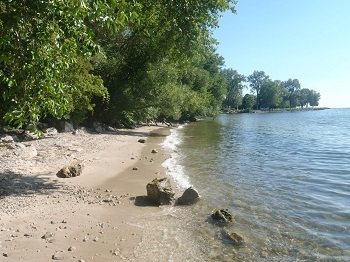|
The following news release was issued earlier this week by the Michigan Department of Energy, Great Lakes, and Environment.
September 28, 2022
Contact:?Jeff Johnston, EGLE Public Information Officer, 517-231-9304
It?s become a frustrating cycle: Each summer since the 1990s, communities in the Western Lake Erie Basin watch and wait to see if another toxic algal bloom will contaminate their drinking water, harm aquatic life, and put a damper on recreation.
Runoff of nutrient-rich water fuels these seasonal blooms of blue-green algae. It happens when releases from wastewater treatment plants and phosphorus and nitrogen from fertilized farm fields and lawns flow into the streams and rivers that feed the lake.

The human impact is no small matter: Lake Erie supplies drinking water for 11 million people. In 2014, an algal bloom left 400,000 people without drinking water for three days after toxins threatened Toledo's water system. A bloom in 2019 was among the most severe and toxic since monitoring began in the early 2000s: It coated around 620 square miles of Lake Erie's surface waters, an area more than eight times the size of Cleveland.
Lake Erie?s algal blooms typically emerge in late summer and can persist into fall. The National Oceanic and Atmospheric Administration (NOAA) has predicted a smaller-than-average bloom this year.
|
In addition to runoff, the lake?s warm and shallow waters and the effects of invasive species contribute to the algae problem, and there may be other factors not yet understood. The State of Michigan is committed to improving Lake Erie, ensuring safe water and supporting healthy ecosystems.
The Michigan Department of Environment, Great Lakes, and Energy (EGLE), Michigan Department of Agriculture and Rural Development (MDARD), and Michigan Department of Natural Resources (DNR) are partners in a 2018 Lake Erie Domestic Action Plan that created a road map to a 40% reduction in phosphorus entering Lake Erie by 2025. Michigan also released an Adaptive Management Plan to reduce phosphorus loading Into Lake Erie in 2021. Reducing the amount of runoff pollution is expected to significantly reduce Lake Erie algae blooms and improve the lake?s health.
A new educational opportunity
Because knowledge is power, too, EGLE will present an educational webinar series, ?Taking Action on Lake Erie,? to take an inside look at ways the state and partners are working together to enhance stewardship of the land and improve water quality in Michigan?s portion of the Western Lake Erie Basin.
The series begins with a session 11 a.m.-noon Wednesday, Oct. 5, highlighting agriculture inventory planning and implementation in the Western Lake Erie Basin led by EGLE?s Nonpoint Source Program and implemented by local conservation districts.
The agricultural inventory process utilizes modeling, desktop analysis, and a field inventory to collect site-specific data to locate and prioritize agricultural sites that have the potential to impact water quality. The goal is to implement agricultural best management practices on sites with the greatest potential to reduce phosphorus loading and improve water quality. This is an opportunity for the public, agency partners, and anyone who wants to know what Michigan is doing to reduce nutrient loading to Lake Erie.
Information and registration are available on the event website. Questions about the webinar may be directed to Michelle Selzer, Lake Erie coordinator in EGLE?s Water Resources Division, at [email protected]. Questions about registration may be directed to training and outreach coordinators Alana Berthold, [email protected], or Joel Roseberry, [email protected].
|